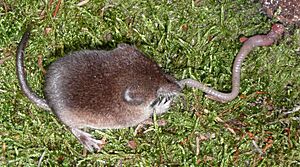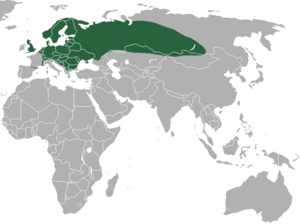Common shrew facts for kids
Quick facts for kids Common shrew |
|
|---|---|
 |
|
| Conservation status | |
| Scientific classification | |
| Genus: |
Sorex
|
| Species: |
araneus
|
 |
|
| Common shrew range | |
| Synonyms | |
|
Sorex europaeus |
|
The common shrew (Sorex araneus), also called the Eurasian shrew, is a tiny mammal found across Northern Europe. This includes places like Great Britain and Scandinavia, but not Ireland. It's one of the most common shrews and even one of the most common mammals in these areas!
Common shrews are small, usually about 5.5 to 8.2 centimeters (2 to 3 inches) long. They weigh between 5 and 12 grams (less than half an ounce). They have soft, dark brown fur with a lighter belly. Young shrews have lighter fur until they shed it for the first time.
These shrews have tiny eyes, a pointy nose that can move, and teeth with red tips. They are also one of the few venomous mammals, which means they can produce a mild venom. Common shrews usually live for about 14 months. They are busy day and night, taking short breaks between long periods of searching for food.
Contents
Where Common Shrews Live
Common shrews live in woodlands, grasslands, and hedgerows across Britain, Scandinavia, and Eastern Europe. Each shrew has its own home area, which is about 370 to 630 square meters (4,000 to 6,800 square feet). Male shrews might make their areas bigger during breeding season to find females.
Shrews are very protective of their homes. They will bravely defend their space from other shrews. They build their nests underground or hidden under thick plants.
What Common Shrews Eat
Common shrews are carnivores and insectivores, meaning they eat meat and insects. Their diet includes insects, slugs, spiders, worms, amphibians (like frogs), and small rodents (like mice).
These tiny animals need to eat a lot to stay alive. They must eat about two to three times their own body weight in food every single day! To do this, a shrew needs to eat every 2 to 3 hours. If a shrew goes without food for more than a few hours, it will starve. Unlike some other small animals, shrews do not hibernate in winter. They are too small to store enough fat, and they can't go long without food.
To survive the cold winter, common shrews have an amazing trick. Their skulls can shrink by almost 20%, and their brains can get smaller by up to 30%! Other body parts also lose weight, and their spines get shorter. This means their total body weight drops by about 18%. When spring arrives, they grow back to their original size. Scientists think that cold temperatures cause their bodies to break down bones and tissues. As it gets warmer, their bodies rebuild them. This helps them need less food in winter, making it easier to survive.
Shrews don't have good eyesight. Instead, they use their excellent senses of smell and hearing to find their food.
How Common Shrews Have Babies
The common shrew's breeding season runs from April to September, with most babies born in the summer. After being pregnant for 24 to 25 days, a female shrew gives birth to a litter of five to seven babies. A female can have two to four litters each year. The young shrews are ready to live on their own within 22 to 25 days.
When young shrews are still small, they sometimes form a "caravan" behind their mother. Each baby holds onto the tail of the shrew in front of it with its mouth, following their mother in a line.
Echolocation
In 2019, scientists discovered something amazing about common shrews: they can use echolocation! This means they make high-pitched sounds and listen for the echoes to figure out what's around them. They use this ability for finding their way in close spaces. This is similar to how bats and bottlenose dolphins navigate. It's a great example of different animals developing the same useful skill independently.
Protection and Population
The common shrew is not an endangered species. This means there are plenty of them around. In Great Britain, common shrews, like other shrews, are protected by the Wildlife and Countryside Act of 1981. This law prevents certain ways of harming them.
In British woodlands, you can find many shrews, sometimes up to one shrew per 200 square meters (about 2,150 square feet). The main animals that hunt shrews are owls, cats, weasels, snakes, stoats, and red foxes.



